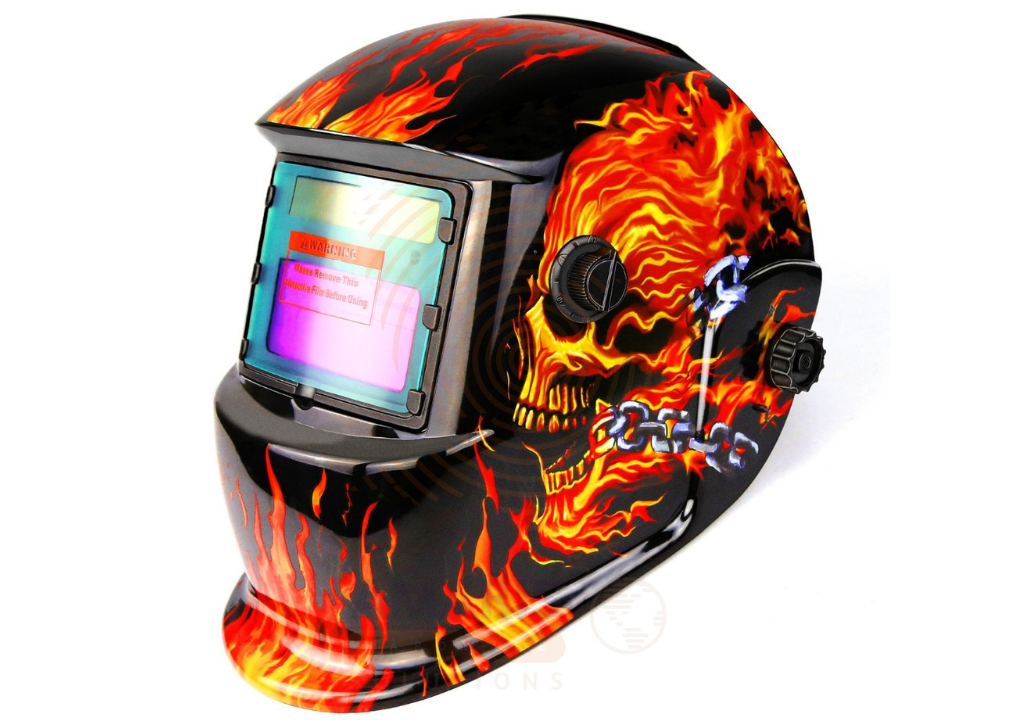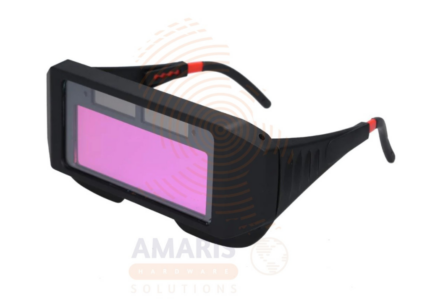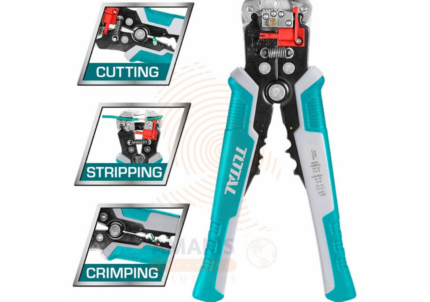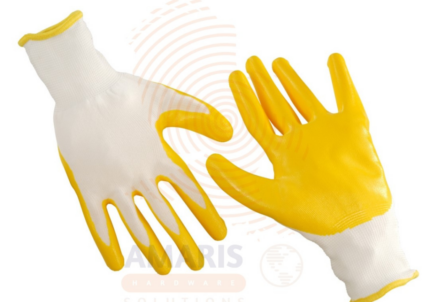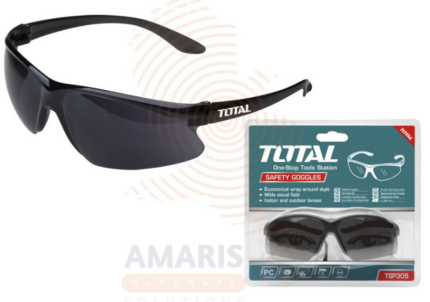Auto Darkening Solar Powered Welding Helmet
WhatsApp Order
An Auto Darkening Solar Powered Welding Helmet is a protective headgear device specifically designed for welders. It incorporates advanced technology to automatically adjust the darkness of the helmet’s lens in response to the intensity of the welding arc. This type of helmet utilizes solar panels to harness and convert sunlight or welding arc light into energy, powering the automatic darkening mechanism. The key feature of an auto-darkening welding helmet is its ability to provide instant and adaptive shading, offering optimal visibility during welding while ensuring the welder’s eyes are protected from harmful ultraviolet and infrared rays.
Categories: Helmets, SAFETY & SECURITY EQUIPMENT, Safety Glasses, WELDING & SOLDERING, Welding Helmets & Gloves
Tags: adjustable welding helmet, auto darkening welding helmet, face protection, protective welding helmet, safety helmet, solar powered welding helmet, welding equipment, welding headgear, welding safety gear
Description
Table of Contents
ToggleAuto Darkening Solar Powered Welding Helmet
Uses
-
Shielding from Arc Light: The primary purpose of the auto-darkening feature is to protect the welder’s eyes from the intense light generated during welding. The helmet darkens instantly when the welding arc is struck and then returns to a lighter state when the arc is extinguished, ensuring continuous eye protection.
-
Increased Productivity: With traditional welding helmets, welders often have to lift the helmet to position the electrode or examine the workpiece, leading to interruptions. Auto-darkening helmets eliminate the need for constant lifting and lowering, improving workflow and overall welding efficiency.
-
Versatility in Welding Processes: These helmets are suitable for various welding processes such as MIG (Metal Inert Gas), TIG (Tungsten Inert Gas), stick welding, and others. They can adapt to different arc intensities and welding conditions.
-
Safety and Eye Health: Auto-darkening helmets protect the welder’s eyes from harmful ultraviolet (UV) and infrared (IR) radiation emitted during welding. Prolonged exposure to such radiation can lead to serious eye injuries, making these helmets crucial for maintaining eye health.
-
User Comfort: These helmets are generally lightweight and ergonomically designed, providing comfort during extended welding sessions. The hands-free operation, coupled with adjustable headgear, contributes to a more comfortable welding experience.
-
Precision and Accuracy: Auto-darkening helmets allow welders to maintain a clear view of the workpiece before and after striking the arc. This improved visibility contributes to better precision and accuracy in welding, especially in intricate or detailed work.
-
Adaptability to Different Lighting Conditions: Auto-darkening helmets are equipped with sensors that detect changes in ambient light. This ensures that the lens adjusts accordingly, providing optimal visibility in various lighting conditions, both indoors and outdoors.
-
Cost-Effective: While auto-darkening helmets may have a higher upfront cost compared to traditional passive helmets, they can be cost-effective in the long run. The increased efficiency and reduced risk of eye injuries may offset the initial investment.
SAFETY HANDLING PRECAUTIONS
Safety Precautions
-
Inspect the Helmet:
-
Regularly check the helmet for any damage or signs of wear. Ensure that all components, including the auto-darkening lens, sensors, and headgear, are in good condition.
-
Verify that the helmet meets relevant safety standards and regulations.
-
-
Adjust the Sensitivity and Delay Settings:
-
Familiarize yourself with the sensitivity and delay settings of the auto-darkening feature.
-
Adjust these settings according to the specific welding process, amperage, and lighting conditions to ensure optimal performance.
-
-
Ensure Proper Fit:
-
Adjust the headgear to achieve a snug and comfortable fit. The helmet should cover the entire face and provide adequate protection to the neck and sides of the head.
-
Ensure that the helmet does not slip during welding, as this could expose the welder to harmful radiation.
-
-
Protective Clothing and Gear:
-
Wear appropriate personal protective equipment (PPE) such as flame-resistant clothing, gloves, and closed-toe shoes.
-
Use additional protective gear, such as a welding jacket, to shield the body from sparks and molten metal.
-
-
Eye and Face Protection:
-
Ensure that the helmet is in the down position before striking the welding arc.
-
Always wear safety glasses with side shields under the welding helmet to provide additional eye protection.
-
-
Maintain a Clean Work Environment:
-
Keep the work area clean and free from combustible materials that could catch fire during welding.
-
Adequately ventilate the workspace to reduce fume exposure and ensure good air circulation.
-
-
Stay Informed about Welding Materials:
-
Be aware of the materials being welded and take necessary precautions for specific hazards associated with those materials.
-
-
Regular Eye Exams:
-
Undergo regular eye examinations to monitor and address any issues related to prolonged exposure to welding light.
-
-
Follow Welding Procedures:
-
Adhere to proper welding techniques and procedures, including maintaining the correct distance and angle between the welding torch and the workpiece.
-
-
Emergency Preparedness:
-
Know the location of emergency equipment such as fire extinguishers and eye wash stations.
-
Have a clear understanding of emergency procedures, including how to quickly remove the helmet in case of an emergency.
-
-
Training and Certification:
-
Ensure that welders are adequately trained and certified for the specific welding tasks they are performing.
-
-
Post-Welding Care:
-
Allow the auto-darkening lens to return to the clear state before inspecting the weld or moving on to another task.
-
If the helmet has a grind mode, make sure to switch to it when grinding to avoid unnecessary darkening of the lens.
-
Related products
ACCESSORIES FOR DIE POLISHER SET
Accessories for Die Polisher Set typically refers to a collection of ten individual components designed for use with a die polisher, with each accessory having a diameter of 6mm. These accessories are likely to be various tools or attachments intended for polishing or refining surfaces in die-cutting applications.
Insulated Safety Boots
Insulated safety boots are a type of footwear designed to provide protection for the feet in hazardous work environments while also offering insulation against extreme temperatures. These boots are commonly used in industries such as construction, manufacturing, and utilities where workers are exposed to various risks, including heavy objects, sharp materials, electrical hazards, and cold weather conditions.
Knitted & Pvc Dots Gloves
- Knitted Gloves: Knitted gloves refer to hand coverings that are crafted through the process of knitting, a method of creating fabric by interlocking loops of yarn. These gloves are typically made from various types of yarn, such as cotton, wool, or synthetic fibers. Knitted gloves are known for their flexibility, comfort, and breathability, making them suitable for a wide range of activities and environments. They come in different styles, thicknesses, and designs to cater to various purposes, from lightweight and dexterous gloves for delicate tasks to heavier and insulated options for colder conditions.
- PVC Dots Gloves: PVC dots gloves are a type of work glove that features small raised dots or patterns made from polyvinyl chloride (PVC) on the palm or fingers. These dots enhance the grip and abrasion resistance of the gloves, providing better control and preventing slips when handling objects. The base material of PVC dots gloves can vary and may include fabrics like cotton, polyester, or a blend of materials. These gloves are commonly used in tasks where a secure grip is essential, such as in construction, manufacturing, or general labor. The PVC dots enhance the overall functionality of the gloves without sacrificing flexibility.
Latex Gloves
Latex gloves are protective coverings for the hands made from natural rubber latex. These gloves are commonly used in various industries, including healthcare and laboratory settings, as well as in everyday tasks. Latex gloves provide a barrier against contaminants, bacteria, and viruses, helping to prevent the transmission of infections. They are known for their elasticity, comfort, and tactile sensitivity, making them suitable for tasks that require precision and dexterity. It's important to note that some individuals may be allergic to latex, and in such cases, alternative materials like nitrile or vinyl gloves may be used.
Leather Gloves
Leather gloves are hand-covering garments made from the tanned hides of animals, typically cows, goats, or sheep. These gloves are crafted by cutting and stitching pieces of leather to form protective coverings for the hands. Leather gloves are valued for their durability, flexibility, and ability to provide a comfortable and stylish barrier against environmental elements, making them widely used for various purposes, including fashion, work, and outdoor activities.
Rubber Coated Gloves (Yellow)
Rubber Coated Gloves (Yellow) are protective handwear designed for improved grip, durability, and safety in industrial, construction, gardening, and general handling tasks. These gloves feature a textured rubber coating—typically on the palm and fingers—over a flexible fabric liner, offering excellent resistance to abrasion, punctures, and light liquid exposure. Their yellow color enhances visibility, making them ideal for work environments where safety and control are critical.
Safety Goggles (only for welding)
Safety Goggles (only for welding) are specialized protective eyewear designed to shield the eyes from intense light, sparks, and debris produced during welding operations. These goggles are fitted with dark-tinted or shaded lenses that filter harmful ultraviolet (UV) and infrared (IR) radiation emitted by welding arcs and flames. They offer a snug, wraparound design to prevent particles and light from entering the sides, making them ideal for gas welding, cutting, brazing, and soldering. Their compact form factor makes them a convenient choice for close-up tasks and confined workspaces.
Welding Googles
Welding goggles are specialized protective eyewear designed to shield the eyes from intense light, sparks, and debris generated during welding processes. They typically feature dark lenses that provide effective protection against the bright arc produced during welding, preventing eye injuries and minimizing the risk of vision damage from ultraviolet (UV) and infrared (IR) radiation. Welding goggles also offer a secure and comfortable fit to ensure the safety and well-being of the wearer while engaged in welding activities.


 Acrylic Sealants
Acrylic Sealants Construction Adhesives
Construction Adhesives Double-Sided Tape
Double-Sided Tape Duct Tape
Duct Tape Electrical Tape
Electrical Tape Epoxy & Resins
Epoxy & Resins Masking Tape
Masking Tape
 Automotive Wrenches & Socket Sets
Automotive Wrenches & Socket Sets Battery Chargers & Jump Starters
Battery Chargers & Jump Starters Car Jacks & Stands
Car Jacks & Stands Car Wash & Detailing Products
Car Wash & Detailing Products Diagnostic Tools
Diagnostic Tools Tire Inflators
Tire Inflators Vehicle Lighting
Vehicle Lighting Oil & Lubricants
Oil & Lubricants
 Adhesives & Sealants
Adhesives & Sealants Bricks & Blocks
Bricks & Blocks Cement & Concrete
Cement & Concrete Drywall & Plaster
Drywall & Plaster Flooring (Tiles, Wood, Laminate)
Flooring (Tiles, Wood, Laminate) Lumber & Plywood
Lumber & Plywood Paints, Primers & Coatings
Paints, Primers & Coatings Insulation Materials
Insulation Materials Roofing Materials
Roofing Materials
 Circuit Breakers
Circuit Breakers Electrical Cables & Wires
Electrical Cables & Wires Switches & Sockets
Switches & Sockets Fuses & Relays
Fuses & Relays Connectors & Terminals
Connectors & Terminals Electrical Boxes & Panels
Electrical Boxes & Panels Conduit & Fittings
Conduit & Fittings Lighting Fixtures & Bulbs
Lighting Fixtures & Bulbs Extension Cords & Power Strips
Extension Cords & Power Strips
 Anchors
Anchors Bolts
Bolts Clips & Clamps
Clips & Clamps Screws
Screws Nuts
Nuts Washers
Washers Rivets
Rivets Nails
Nails Threaded Rods
Threaded Rods
 Hammers
Hammers Measuring Tools (Tapes, Levels, Calipers)
Measuring Tools (Tapes, Levels, Calipers) Screwdrivers
Screwdrivers Pliers & Cutters
Pliers & Cutters Saws & Blades
Saws & Blades Chisels & Punches
Chisels & Punches Allen Keys & Hex Keys
Allen Keys & Hex Keys Ratchets & Socket Sets
Ratchets & Socket Sets Wrenches & Spanners
Wrenches & Spanners
 Power Tool Accessories (Blades, Bits, Discs)
Power Tool Accessories (Blades, Bits, Discs) Rotary Tools
Rotary Tools Saws (Circular, Jigsaw, Reciprocating)
Saws (Circular, Jigsaw, Reciprocating) Drills & Drivers
Drills & Drivers Grinders & Sanders
Grinders & Sanders Heat Guns
Heat Guns Nail Guns
Nail Guns Impact Wrenches
Impact Wrenches Batteries & Chargers
Batteries & Chargers
 Pipes & Fittings (PVC, Copper, PEX)
Pipes & Fittings (PVC, Copper, PEX) Plumbing Tools
Plumbing Tools Pumps & Motors
Pumps & Motors Sealants & Adhesives for Plumbing
Sealants & Adhesives for Plumbing Valves & Taps
Valves & Taps Water Heaters
Water Heaters Drainage Systems
Drainage Systems Faucets & Fixtures
Faucets & Fixtures Hoses & Tubing
Hoses & Tubing
 Hinges & Latches
Hinges & Latches Hooks & Brackets
Hooks & Brackets Window Hardware
Window Hardware Chains & Cables
Chains & Cables Casters & Wheels
Casters & Wheels Shelving & Storage Systems
Shelving & Storage Systems Door Handles & Locks
Door Handles & Locks Drawer Slides & Cabinet Hardware
Drawer Slides & Cabinet Hardware
 Personal Protective Equipment (PPE)
Personal Protective Equipment (PPE) Respirators & Masks
Respirators & Masks Safety Glasses
Safety Glasses Safes
Safes Security Cameras
Security Cameras Gloves
Gloves Helmets
Helmets Ear Protection
Ear Protection Fire Safety Equipment
Fire Safety Equipment Locks & Padlocks
Locks & Padlocks Motion Sensors & Alarms
Motion Sensors & Alarms
 Garden Fencing
Garden Fencing Garden Furniture Hardware
Garden Furniture Hardware Lawn Mowers
Lawn Mowers Trimmers & Edgers
Trimmers & Edgers Shovels & Spades
Shovels & Spades Rakes & Hoes
Rakes & Hoes Pruning Shears & Loppers
Pruning Shears & Loppers Watering Systems (Hoses, Sprinklers, Nozzles)
Watering Systems (Hoses, Sprinklers, Nozzles)
 Interior Paints
Interior Paints Paint Brushes & Rollers
Paint Brushes & Rollers Paint Strippers & Thinners
Paint Strippers & Thinners Paint Trays & Accessories
Paint Trays & Accessories Exterior Paints
Exterior Paints Spray Paints
Spray Paints Primers & Undercoats
Primers & Undercoats Varnishes & Stains
Varnishes & Stains
 Gaskets & Seals
Gaskets & Seals Hydraulic Fittings
Hydraulic Fittings Industrial Fasteners
Industrial Fasteners Industrial Hoses
Industrial Hoses Lubricants & Greases
Lubricants & Greases Metal Sheets & Bars
Metal Sheets & Bars Bearings & Bushings
Bearings & Bushings Belts & Pulleys
Belts & Pulleys
 HVAC Filters
HVAC Filters Insulation for HVAC
Insulation for HVAC Air Conditioners
Air Conditioners Refrigerants
Refrigerants Ventilation Ducts & Fittings
Ventilation Ducts & Fittings Thermostats & Controllers
Thermostats & Controllers Fans & Blowers
Fans & Blowers
 Pegboards & Hooks
Pegboards & Hooks Shelving Units
Shelving Units Storage Bins & Containers
Storage Bins & Containers Toolboxes & Tool Chests
Toolboxes & Tool Chests Workbenches
Workbenches Drawer Organizers
Drawer Organizers Labeling Supplies
Labeling Supplies
 Welding Accessories (Clamps, Brushes)
Welding Accessories (Clamps, Brushes) Welding Electrodes & Rods
Welding Electrodes & Rods Welding Helmets & Gloves
Welding Helmets & Gloves Welding Machines
Welding Machines Soldering Irons & Stations
Soldering Irons & Stations Flux & Solder Wire
Flux & Solder Wire
 Generator Accessories
Generator Accessories Inverters
Inverters Portable Generators
Portable Generators Power Inverters
Power Inverters Transfer Switches
Transfer Switches Diesel & Gasoline Generators
Diesel & Gasoline Generators
 Transport Equipment: Carts, Dollies, and Hand Trucks
Transport Equipment: Carts, Dollies, and Hand Trucks Storage Solutions: Pallets, Racks, and Containers
Storage Solutions: Pallets, Racks, and Containers Lifting Equipment: Hoists, Cranes, and Jacks
Lifting Equipment: Hoists, Cranes, and Jacks Conveyors and Accessories: Belts and Rollers
Conveyors and Accessories: Belts and Rollers